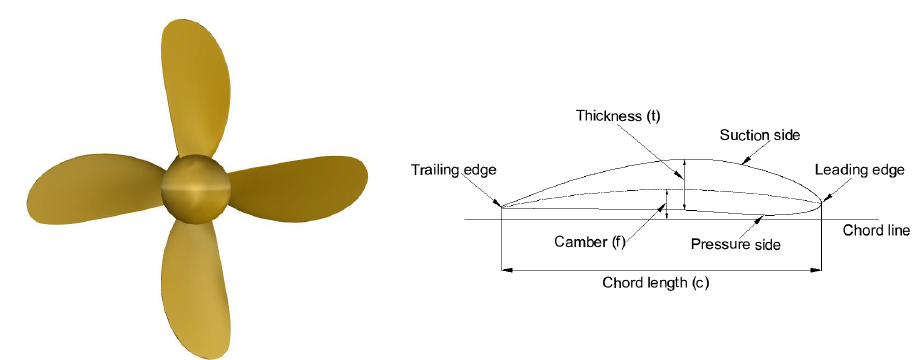Hydrodynamic Performance Analysis of Camber Ratio Variations on B-series Propeller Types
DOI:
https://doi.org/10.37934/cfdl.16.7.3953Keywords:
B-Series, Camber, CFD, Efficiency, Polynomial, RANSEAbstract
The hydrodynamic performance of the B-series propeller can be determined by calculating the polynomial equation published by MARIN. Furthermore, analysis and evaluation of B-series propeller modifications can be done by varying the camber ratio of the foil. The camber ratio affects the lift force on the propeller foil, directly affecting the propeller thrust and torque. Numerical calculations were carried out using Computational Fluids Dynamics (CFD), based on Reynolds Averaged Navier Stokes Equations (RANSE) and turbulence model in the form of explicit algebraic stress models (EASM). The overall results of this study show an increase in efficiency of 4.182 on the foil with a camber ratio of 2.2% when compared to the foil camber ratio of 0%.
Downloads
References
Watanabe, Takayuki, Takafumi Kawamura, Yoshihisa Takekoshi, Masatsugu Maeda, and Shin Hyung Rhee. "Simulation of steady and unsteady cavitation on a marine propeller using a RANS CFD code." In Proceedings of The Fifth International Symposium on Cavitation (Cav. 2003.
Bajuri, Muhammad Nur Arham, Djamal Hissein Didane, Mahamat Issa Boukhari, and Bukhari Manshoor. "Computational Fluid Dynamics (CFD) Analysis of Different Sizes of Savonius Rotor Wind Turbine." Journal of Advanced Research in Applied Mechanics 94, no. 1 (2022): 7-12. https://doi.org/10.37934/aram.94.1.712
Tey, Wah Yen, Yutaka Asako, Nor Azwadi Che Sidik, and Rui Zher Goh. "Governing equations in computational fluid dynamics: Derivations and a recent review." Progress in Energy and Environment (2017): 1-19.
Hayati, A. N., S. M. Hashemi, and M. Shams. "A study on the effect of the rake angle on the performance of marine propellers." Proceedings of the Institution of Mechanical Engineers, Part C: Journal of Mechanical Engineering Science 226, no. 4 (2012): 940-955. https://doi.org/10.1177/0954406211418588
Wallin, Stefan. Engineering turbulence modelling for CFD with focus on explicit algebraic Reynolds stress models. Stockholm, Sweden: Royal Institute of Technology, Department of Mechanics, 2000.
Jadmiko, Edi, Raja Oloan Saut Gurning, Muhammad Badrus Zaman, and Endang Widjiati. "Variations Rake Angle Propeller B–Series Towards Performance and Cavitation with CFD Method." Journal of Advanced Research in Fluid Mechanics and Thermal Sciences 106, no. 2 (2023): 78-86. https://doi.org/10.37934/arfmts.106.2.7886
Suranto, Maful, I. Made Ariana, and Achmad Baidowi. "Analysis of The Effect of Pitch Angle on Propeller Modification by Considering Wake Distribution on Propeller Performance." In IOP Conference Series: Earth and Environmental Science, vol. 972, no. 1, p. 012049. IOP Publishing, 2022. https://doi:10.1088/1755-1315/972/1/012049
Gaafary, M. M., H. S. El-Kilani, and M. M. Moustafa. "Optimum design of B-series marine propellers." Alexandria Engineering Journal 50, no. 1 (2011): 13-18. https://doi.org/10.1016/j.aej.2011.01.001
Adietya, Berlian Arswendo, I. Ketut Aria Pria Utama, and Wasis Dwi Aryawan. "CFD Analysis into the Effect of using Propeller Boss Cap Fins (PBCF) on Open and Ducted Propellers, Case Study with Propeller B-Series and Kaplan-Series." CFD Letters 14, no. 4 (2022): 32-42. https://doi.org/10.37934/cfdl.14.4.3242
Ariana, I. M., and B. Cahyono. "Optimization of Propeller Design Through Polynomial Approach to Optimize The Ship Energy Efficiency." In IOP Conference Series: Earth and Environmental Science, vol. 557, no. 1, p. 012051. IOP Publishing, 2020. https://doi:10.1088/1755-1315/557/1/012051
Carlton, J. "Marine Propellers and Propulsion, 2nd edn., Buttersworth." (2007).
Numeca International - Cadence Design Systems. n.d. “FINEMarine-Theory-Guide.”
Menter, Florian R. "Two-equation eddy-viscosity turbulence models for engineering applications." AIAA journal 32, no. 8 (1994): 1598-1605. https://doi.org/10.2514/3.12149
Abbott, Ira H., and E. Albert. "Von Doenhoff. 1959. Theory of Wing Sections." Dover Publications, New York 268: 33-47.
Nouri, Nowrouz Mohammad, and Saber Mohammadi. "Numerical investigation of the effects of camber ratio on the hydrodynamic performance of a marine propeller." Ocean Engineering 148 (2018): 632-636. https://doi.org/10.1016/j.oceaneng.2017.06.026
ITTC Recommended Procedures and Guidelines. 2014. Practical Guidelines for Ship Self-Propulsion CFD. Report
Abobaker, Mostafa, Sogair Addeep, Lukmon O. Afolabi, and Abdulhafid M. Elfaghi. "Effect of Mesh Type on Numerical Computation of Aerodynamic Coefficients of NACA 0012 Airfoil." Journal of Advanced Research in Fluid Mechanics and Thermal Sciences 87, no. 3 (2021): 31-39. https://doi.org/10.37934/arfmts.87.3.3139
Molland, A. F., and I. K. A. P. Utama. "Experimental and numerical investigations into the drag characteristics of a pair of ellipsoids in close proximity." Proceedings of the Institution of Mechanical Engineers, Part M: Journal of Engineering for the Maritime Environment 216, no. 2 (2002): 107-115. https://doi.org/10.1243/147509002762224324
Anthony F.Molland. (2011). Practical Estimation of Ship Propultion Power. Cambridge University Press, p. 32 Avenue of the Americas, New York, NY 10013-2473, USA
ITTC Recommended Procedures and Guidelines. 2014. Open Water Test, Revision 3, page 3 of 11.
Edward V. Lewis, Editor. (1988). Principles of Naval Architecture Second Revision, Published by The Society of Naval Architecture and Marine Engineers. 601 Pavonia Avenue, Jersey City
Suastika, Ketut, Ahmad Septiawan Saputra, Adnan Faiz Fauzi, and Ahmad Firdhaus. "Comparison of Performance of Straight-and V-shaped Vanes Applied as Energy Saving Device to High-speed Boats." CFD Letters 15, no. 10 (2023): 110-122. https://doi.org/10.37934/cfdl.15.10.110122
Versteeg, Henk Kaarle, and Weeratunge Malalasekera. An introduction to computational fluid dynamics: the finite volume method. Pearson education, 2007.




























